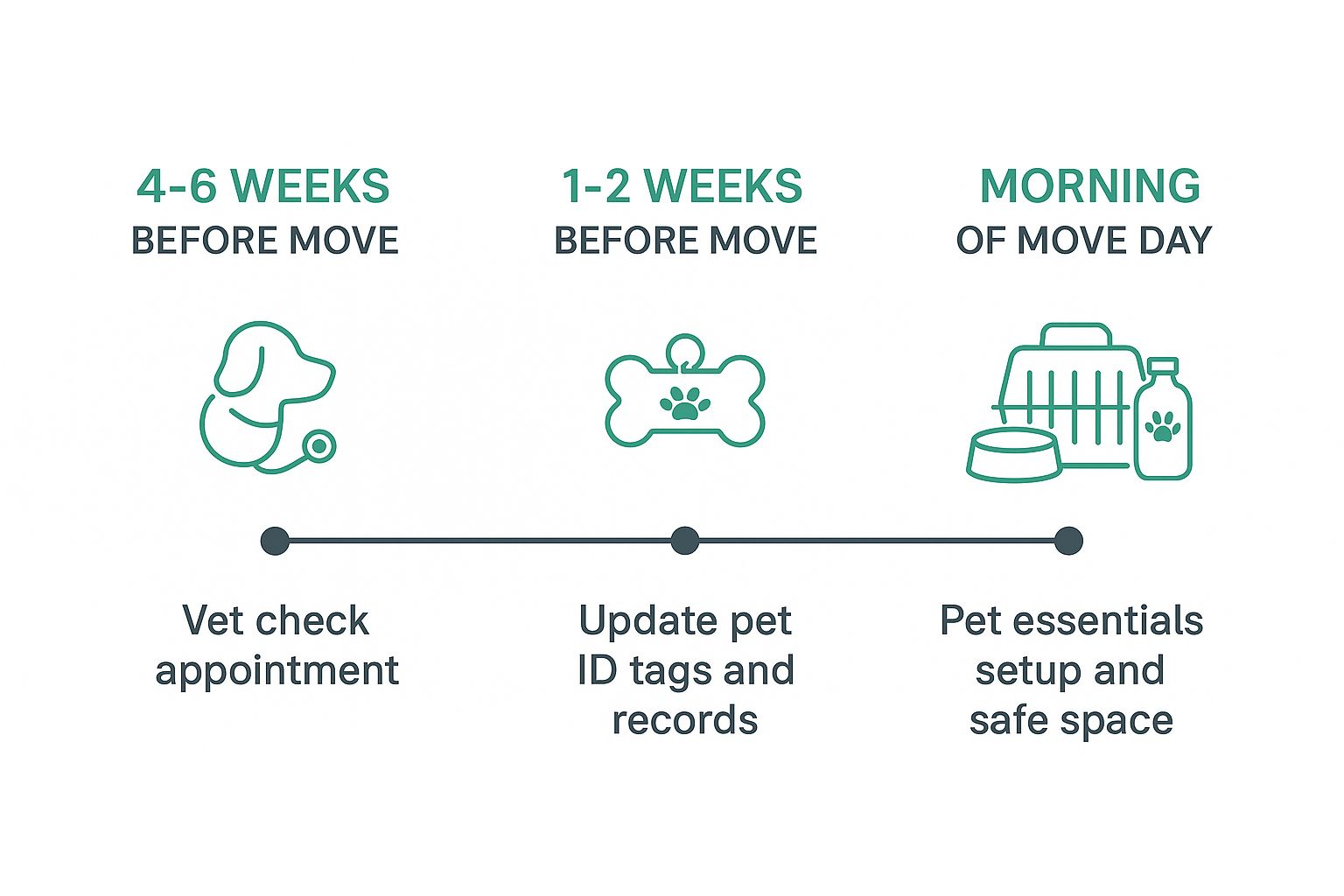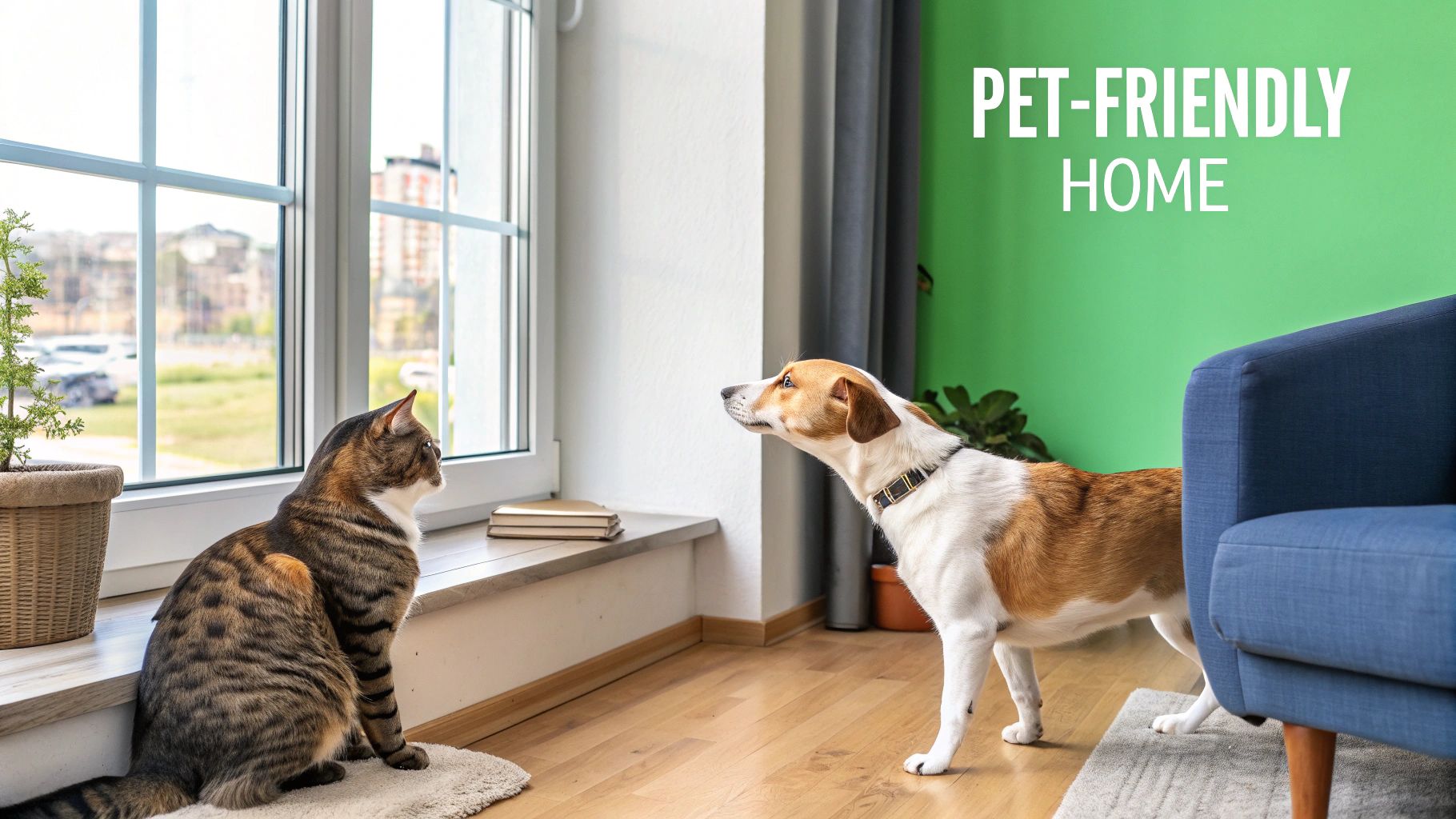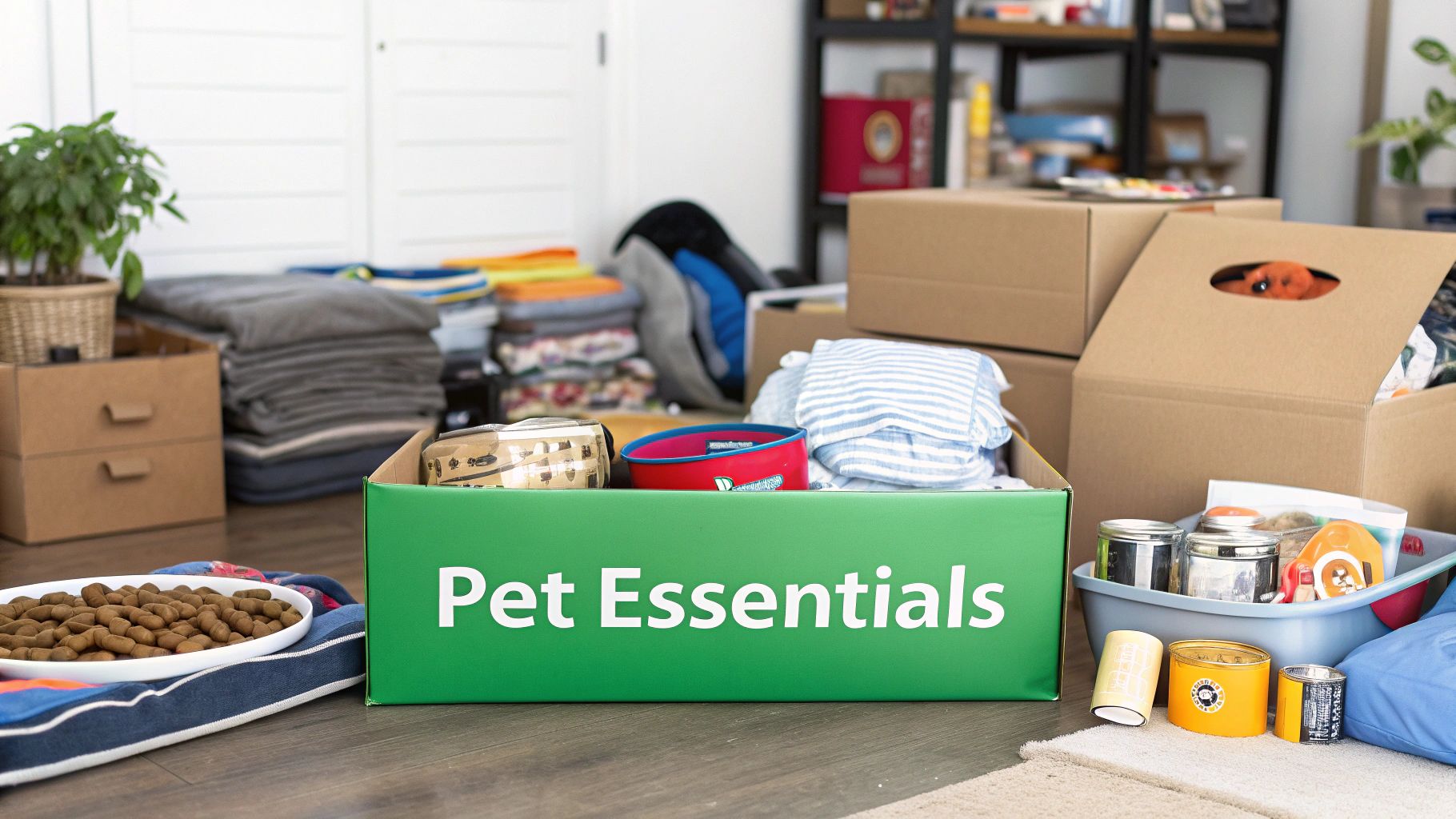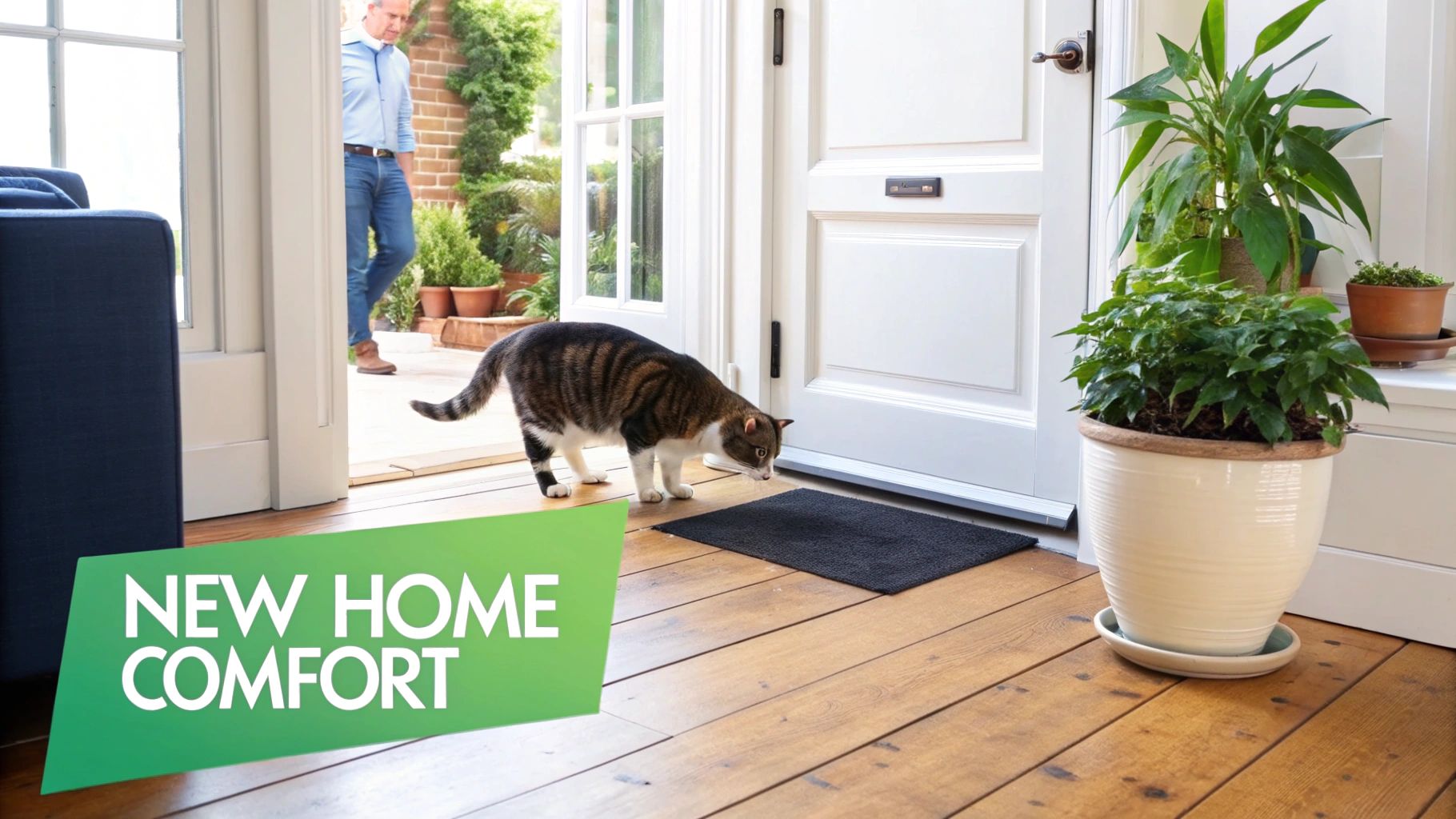Moving house is stressful enough for us, but for our pets, it can be a world of confusion and anxiety. They don't understand the boxes, the chaos, or the sudden change in their environment. That's why having a solid, pet-centric plan is non-negotiable. It's not about just getting them from Point A to Point B; it's about making the entire journey as smooth and fear-free as possible.
The secret? Breaking it all down into manageable chunks, starting weeks ahead of time. A little forethought goes a long way in keeping your furry, feathered, or scaled family member happy and secure.
Your Pet-Friendly Moving Timeline
Let's be honest, a last-minute scramble is a recipe for a stressed-out pet. A successful move really comes down to good old-fashioned preparation. By spreading out the pet-related tasks, you can avoid that panicked, final-week rush and focus on what truly matters: your companion's wellbeing.
Think of it as a gradual process. Starting a month or more before the moving truck arrives gives you breathing room for vet visits, updating details, and slowly getting your pet used to the idea that things are changing.
Four to Six Weeks Before Moving Day
First on your list should be a trip to the vet. This is your opportunity to get a complete copy of your pet’s medical records, check that all their vaccinations are current, and stock up on any prescriptions. It’s a good time to chat about travel anxiety, too. Your vet can recommend calming options, from pheromone diffusers to anxiety wraps, that might make all the difference.
If you’re moving interstate, particularly to somewhere with strict biosecurity laws like Tasmania or Western Australia, now's the time to ask about health certificates or specific treatments. Getting this sorted early will save you a world of headaches later on.
One to Two Weeks Before Moving Day
With the move drawing closer, it’s time to tackle the admin. Your pet's identification is top priority. Order a new tag with your new address and phone number. Crucially, don't forget to update their microchip details. You can usually do this online or over the phone. A lost pet is every owner's nightmare during a move, and an up-to-date microchip is their best chance of a swift return.
This is also the perfect time to pack your pet’s "essentials kit". Grab a dedicated bag or a clearly marked box and fill it with everything they’ll need for the first 24-48 hours in the new place.
Pro Tip: Make sure this essentials kit is the very last thing you load and the first thing you unload. Having immediate access to their food, water bowls, favourite toy, bedding, and medication helps create a slice of familiarity amidst the strangeness of a new home.
To help you stay on track, we've put together a handy timeline that covers the key stages, from those initial vet appointments right through to setting up a safe space on moving day.

As the visual guide shows, spreading these tasks out over several weeks is the key to a calm and organised pet move.
Here’s a quick summary of the tasks to keep you on track.
Pet-Friendly Moving Timeline At A Glance
| Timeframe | Key Tasks for Your Pet |
|---|---|
| 4-6 Weeks Out | Schedule vet check-up, get medical records, update vaccinations, refill prescriptions, and inquire about travel needs (e.g., health certificates for interstate moves). |
| 1-2 Weeks Out | Update microchip details, order new ID tags, and start packing a pet essentials kit with food, bowls, toys, bedding, and medication. |
| Week of the Move | Keep routines (feeding, walks) as normal as possible. Secure your pet in a safe, quiet room on moving day. Confirm pet-sitter or travel plans. |
| Moving Day | Transport your pet safely in your own vehicle if possible. Set up their "safe room" at the new house first with all their familiar items. |
| After the Move | Stick to old routines. Supervise outdoor time in the new yard. Be patient as they adjust to their new surroundings. |
Following this timeline will help ensure no detail is overlooked during the busiest moments of your move.
The Week of the Move
As moving day looms, consistency is your best friend. Do your best to stick to your pet’s regular feeding, walking, and playtime schedules. This routine provides an anchor of normality for them when everything else is in upheaval.
While you're finalising your own to-do list, don't forget all the official address changes you need to make. For a complete rundown, our comprehensive moving house change of address checklist is a lifesaver. This is especially vital in Australia, a nation of animal lovers. With around 28.7 million pets and 69% of households owning at least one, moving with pets is a common challenge for many families.
Preparing Your Pet for Moving Day

The secret to a smoother move with your furry (or feathered) family members is getting them used to the idea long before the first box is even taped shut. A bit of forward-thinking preparation can turn what might be a terrifying experience for them into just another day.
It all starts with slowly introducing the signs of the move. Don’t just suddenly flood a room with boxes and packing tape; that’s a one-way ticket to an anxious pet. Think gradual.
A few weeks before you seriously start packing, just place a couple of empty, open boxes in a corner of the living room. Let your pets sniff them, explore them, maybe even claim one as a new nap spot. For most cats, a box is an object of intense curiosity anyway. By making them a normal part of the furniture, you’re dialling down the potential for fear.
Normalising Moving Supplies
The whole point is to build a positive—or at the very least, neutral—connection with all these new things. A pet’s world is built on routine and familiarity, so the sudden invasion of packing materials can really throw them off.
Here are a few tricks I’ve seen work wonders:
- Become a treat fairy. Casually drop high-value treats inside and around the boxes for your pet to "discover" on their own.
- Move dinner time. Start feeding them their meals near the stack of boxes. This forges a powerful link between the strange new items and something they absolutely love.
- Initiate playtime. Grab their favourite toy and have a game of fetch or tug-of-war right beside the packing supplies to show them it's all part of a safe, fun environment.
This slow-burn approach helps them understand that these new objects aren’t a threat to their territory.
Making the Carrier a Safe Haven
Let’s be honest, for most pets, the carrier only ever means one thing: a stressful trip to the vet. It’s no surprise they run for the hills the moment they see it. Your mission, should you choose to accept it, is to completely rebrand the carrier in their mind. It needs to go from a cage to a cosy, personal den.
Start this transformation weeks before the move. Put the carrier in a main living area, but take the door off or securely prop it open. Make it comfy and inviting. Line it with their favourite blanket, toss in an old t-shirt that smells like you, and add a special toy.
I once had a cat who would panic at the mere sight of his carrier. By leaving it open in the living room and randomly tossing his favourite treats inside for two weeks, he started napping in it voluntarily. On moving day, he walked in without any fuss—a massive win.
This strategy of turning a negative into a positive is fundamental. It gives them a sense of control and a secure space they can retreat to when things get overwhelming.
Addressing Anxiety with Calming Aids
Even with the best preparation in the world, some pets are just naturally more anxious. The constant activity, strange smells, and total upheaval of their routine can still be too much. For these sensitive souls, it’s smart to bring in some extra support.
Pheromone diffusers can be incredibly effective. They release synthetic versions of calming animal hormones into the air. Plug one in near your pet’s favourite snoozing spot a couple of weeks before the move to create a more serene atmosphere.
If your pet’s anxiety is more severe, a chat with your veterinarian is the best course of action. They can assess your pet’s specific needs and might recommend modern anti-anxiety medications, which are a much safer option than older sedatives that can carry risky side effects. You can also look into things like Pet Remedy calming solutions to help take the edge off during this stressful time.
Choosing Professional Pet Relocation Services

If you're just moving across Perth, you can probably manage your pet’s transport yourself. But what happens when your move involves a long-haul journey across state lines? Moving house with pets anywhere in Australia can quickly become a tangled mess of logistics, from navigating state-specific biosecurity rules to deciphering airline regulations.
This is exactly where professional pet relocation services prove their worth. These aren't just delivery drivers for animals; they're expert coordinators who manage every single detail of your pet’s journey, ensuring it's as safe and low-stress as possible. They handle everything from booking pet-friendly flights to arranging climate-controlled road transport, freeing you up to focus on everything else that comes with a big move.
Understanding What Pet Transporters Do
Think of a reputable pet relocation service as a specialised travel agent for your furry (or feathered) family member. They offer a comprehensive suite of services designed to cover every possible aspect of the trip from start to finish.
A good service will often handle:
- Door-to-Door Service: They can collect your pet right from your old home and deliver them directly to your new one, managing every leg of the journey in between.
- Flight Coordination: With established airline relationships, they know the ins and outs of booking pet travel, including which aircraft are suitable and the most direct, pet-friendly routes.
- IATA-Compliant Travel Crate: Professionals will either provide or help you select the perfect size and type of travel crate that meets the strict International Air Transport Association (IATA) standards.
- Paperwork and Health Checks: They guide you through all the necessary veterinary paperwork, ensuring vaccinations and health certificates are perfectly documented for interstate travel.
Having this professional oversight is a lifesaver, especially for moves into states with stringent entry rules like Western Australia or Tasmania. It completely removes the guesswork and the risk of making a costly, stressful mistake.
The demand for these services is on the rise, which really shows how much Australians prioritise their pets' welfare during a move. The Australian pet travel services market is booming, projected to grow from an estimated US$35.6 million in 2024 to about US$65.6 million by 2030. You can learn more about the growth of pet relocation services and its drivers.
How to Vet a Pet Relocation Company
Picking the right company is, without a doubt, the most important decision you'll make in this process. Not all transporters are created equal, and your pet’s safety has to be the top priority. It’s time to do your homework and ask some tough questions to find a service you can genuinely trust.
Don’t just jump at the cheapest quote. Your decision should hinge on safety protocols, experience, and transparent communication. A slightly higher price tag often means better standards of care, more experienced staff, and superior equipment.
As you shortlist potential companies, zero in on their credentials and how they operate. A quality company will be open and proud of its processes.
How to Choose a Pet Relocation Service
Finding the right partner for your pet’s journey requires a bit of detective work. Use this table as a guide to compare services and make sure you're asking the right questions.
| Service Feature | What to Look For | Crucial Questions to Ask |
|---|---|---|
| Accreditation & Insurance | Membership with industry bodies like the Pet Industry Association of Australia (PIAA) and proof of full public liability insurance. | Are you a member of any professional pet transport associations? Can you provide a copy of your insurance certificate? |
| Animal Welfare Policies | Clear, written policies on hydration, exercise, and checks during transit. Climate-controlled vehicles are non-negotiable. | What is your procedure for rest stops on long road journeys? How often are the animals checked on? Are your vehicles climate-controlled? |
| Staff Experience & Training | Staff professionally trained in animal handling, pet first aid, and recognising signs of stress. | What specific training does your staff receive in animal handling and welfare? How many years have you been transporting pets? |
| Communication & Updates | A clear communication plan, detailing how and when you'll get updates during your pet's journey. A dedicated contact person is a huge plus. | How and when will I receive updates during transit? Who is my direct point of contact if I have a question or concern? |
Taking the time to properly vet a service gives you the peace of mind that your beloved pet is in the safest possible hands. This diligence is what ensures they arrive at their new home happy, healthy, and ready to start the next chapter with you.
Navigating Australian Interstate Travel Rules
Moving house with pets in Australia isn't always as simple as packing them into the car and hitting the road. Our country's robust biosecurity system is there for a good reason—to protect our unique ecosystems and vital agricultural industries. This means each state and territory has its own set of rules for animals crossing its borders.
While a move between, say, New South Wales, Victoria, and Queensland is generally straightforward for common pets like cats and dogs, other states are a different story. The last thing anyone wants is to be turned away at a border checkpoint or, even worse, have their pet face quarantine because a crucial piece of paperwork was missed. This is one part of your move where you absolutely must plan ahead.
The Strictest States: Western Australia and Tasmania
If your new home is in Western Australia or Tasmania, get ready for some extra prep work. These two states have the most stringent entry conditions in the country, largely to protect their fragile environments and significant farming sectors from pests and diseases found elsewhere in Australia.
For a move to either WA or Tassie, you’ll need to get organised well in advance. Here’s what you’ll likely be looking at:
- A Health Certificate: You'll need a vet to issue a certificate confirming your pet is healthy and free from contagious diseases, usually within a specific timeframe just before you travel.
- Up-to-Date Vaccinations: Your pet's vaccination records must be complete and current. No exceptions.
- Mandatory Parasite Treatments: This is a big one. You'll need proof of specific treatments, like for hydatid tapeworm if you're taking a dog to Tasmania, or for ticks before entering WA. A vet must administer and document these treatments within a set period.
As a real-world example, taking a dog to Tasmania requires proof from a vet that it was treated for hydatid tapeworm within 14 days of arriving. If you can't show this, you could face a hefty fine or be denied entry. It's crucial to check the official government biosecurity websites for the latest rules, because they can and do change.
International Arrivals and Quarantine
Bringing a pet into Australia from overseas is an even more complex process. Australia is famously rabies-free, and our quarantine laws are among the strictest in the world to keep it that way and protect our native wildlife.
Depending on where your pet is coming from, they could face a quarantine period of 10 to 30 days at a dedicated government facility. This involves vet exams, vaccinations, and various treatments to ensure they're not bringing any unwanted diseases into the country.
This isn't something you can arrange at the last minute. It requires months of planning, involving import permits, specific blood tests, and numerous health certifications. Honestly, your best bet is to hire a professional pet relocation service that specialises in international moves. They know the system inside out and can manage the mountain of paperwork and logistics for you.
Your Essential Pet Paperwork Checklist
No matter where you're moving, having your pet's documents organised is non-negotiable. I always suggest keeping a dedicated folder—either a physical one or a digital one on your phone—with everything you need in one place.
Here’s a quick checklist of what to include:
- Full Vaccination Records: The complete history, with dates, vaccine types, and the administering vet's details.
- Microchip Registration: A certificate showing the microchip number and proof that you’ve updated your contact details to your new address.
- Veterinary Health Certificate: The original copy if it's required for your interstate move.
- Proof of Parasite Treatment: Any official, vet-signed forms confirming mandatory flea, tick, or worm treatments have been done.
Having these documents ready to go isn't just for passing biosecurity checks; it makes registering with a new vet at your destination a breeze. It’s just another one of those critical admin tasks, much like updating your own personal details. Our guide on how to change your address when moving in Australia can help you get on top of all those updates. A little bit of prep work here will make the whole journey smoother for you and your furry friend.
Helping Your Pet Settle Into the New Home

The chaos of moving day is finally over, and the last box has been carried inside. For you, it’s a moment of relief. But for your pet, the most confusing part of moving house with pets is just getting started. They’ve been dropped into an unfamiliar territory, one filled with strange smells and no established routine. Your final, and arguably most important, job is to help them realise that this strange new place is now their safe and loving home.
The journey to helping them adjust actually begins before they even set a paw inside. A little forward planning can make all the difference between a stressed-out pet and a confident one. It’s all about creating a sense of security and familiarity from the moment they arrive.
Create a Secure Home Base
Before you let your pet have free rein of the new house, set up a dedicated 'safe room' for them. In my experience, this is one of the most effective strategies for a smooth transition. Pick a quiet room away from the main hustle and bustle, like a spare bedroom, study, or even a laundry.
Get in there before bringing your pet inside and fill it with all their familiar things: their bed or crate, favourite blankets, toys, food and water bowls, and a litter tray for cats. The idea is to create a small, manageable space that smells just like them—a little pocket of the old home in the new one.
Once they're in their room, close the door and just let them be. This gives them a secure anchor point from which they can slowly begin to explore the rest of the house on their own terms. It stops them from feeling completely overwhelmed by a huge new space all at once.
My cat spent the first full day in his safe room, only poking his head out at night. By the next morning, he was cautiously exploring the hallway. This gradual approach allowed him to build confidence without the stress of navigating a huge, unknown territory.
Pet-Proofing Your New Space
While your pet is getting comfortable in their safe room, use that time to do a thorough pet-proofing sweep of the rest of the house. A new home brings new and unknown hazards.
- Check for Escape Routes: Look for gaps in fences, loose window screens, or doors that don’t latch properly. A scared or disoriented pet is much more likely to bolt.
- Secure Potential Dangers: Tuck away loose electrical cords, ensure any leftover cleaning supplies are stored safely, and check for toxic plants that may have been left by previous owners.
- Look for Small Hazards: Get down on their level and scan for things left behind by previous occupants or builders, like nails, staples, or small bits of plastic that could be swallowed.
This proactive safety check gives you peace of mind, ensuring that when your pet is finally ready to explore, they can do so without risk.
Re-establishing a Familiar Routine
Pets thrive on predictability. It's their comfort zone. One of the best ways to help them settle is to get back to your old routine as quickly as you possibly can. This reinforces a sense of normality and helps them understand that while the location has changed, their life with you hasn't.
Try to stick to their established schedule for everything that matters to them:
- Feeding Times: Serve meals at the exact same time you always did. This is a massive signal of stability for them.
- Walks and Playtime: Keep daily walks and play sessions consistent. The familiar activity is reassuring.
- Bedtime Rituals: If you have a specific routine before bed—a final trip outside, a certain treat—stick to it.
This consistency acts as a powerful signal that everything is okay. It tells them that despite the new surroundings, the fundamental structure of their world remains secure. Patience is your best tool here; it can take a few days or even weeks for a pet to fully adjust. By providing a secure base, a safe environment, and a predictable routine, you're setting them up for a happy and calm transition into your new life together.
Your Questions on Moving With Pets Answered
Even when you’ve planned everything down to the last detail, moving house with pets can still throw you a few curveballs. Every animal is different, and so is every move, which means you’re bound to have some very specific questions pop up. To help you tackle these common hurdles, we've put together some straight-up answers to the queries we hear most often from pet owners.
Think of this as your quick-reference guide for those tricky situations that might arise, helping you feel more prepared for whatever moving day has in store.
How Can I Keep My Cat From Running Away at the New House?
This is a huge, and very valid, concern for any cat owner. Cats are creatures of territory, and being dropped into a new, unfamiliar environment can easily send them into a panic, often trying to find their way back "home." The trick here is a slow, patient introduction to their new domain.
For the first two to three weeks, your cat must be kept strictly indoors. I know it can be tough, but this period is non-negotiable. It gives them the time they need to form a new bond with the house, slowly accepting it as their own territory. While they're inside, make their new world as exciting as possible with plenty of toys, scratching posts, and interactive play to keep their minds off the great outdoors.
Before you even consider letting them out, make absolutely sure their microchip details have been updated with your new address. When that first venture outside finally happens, supervise it closely. Join them for just a few minutes at a time, ideally right before a meal. A rumbling tummy is a great incentive to come back inside!
What Is the Best Way to Transport a Bird or Small Animal?
Moving with smaller, more delicate pets like birds, guinea pigs, or hamsters demands extra care. The main goal is to keep stress to an absolute minimum and ensure they are physically safe during the journey.
Always use a secure, well-ventilated travel cage. It needs to be big enough for them to stand and turn around comfortably, but not so big that a sudden stop could send them flying. A smaller, snugger space is often a much safer choice.
My Two Cents: I always recommend covering three sides of the cage with a light, breathable cloth. It cuts down on overwhelming visual chaos, which is a major stressor for prey animals, while still allowing for that all-important airflow. And it goes without saying, but never leave small pets in a parked car—the temperature can become lethal in just a few minutes.
Also, check that any food and water dispensers are secure and won't spill everywhere. For hydration, a slice of a water-heavy vegetable like cucumber is a fantastic trick. It gives them moisture without the mess of a sloshing water bowl.
Should I Sedate My Pet for the Move?
This question comes up all the time, but the advice from vets has really changed over the years. In almost every situation, vets advise against sedating pets for travel, particularly for air travel. Older-style sedatives can mess with an animal's balance and breathing, which is a serious risk when they're alone in a cargo hold or carrier.
A far better approach is to focus on proactive calming strategies. As we've mentioned, getting your pet comfortable with their carrier long before the move is the single most effective thing you can do. When you combine this with calming products like pheromone sprays (Feliway for cats, Adaptil for dogs) or an anxiety wrap, you have a much safer and more humane solution.
If your pet has severe travel anxiety, you absolutely need to chat with your vet. They might prescribe a modern anti-anxiety medication, which is completely different from a sedative. These drugs work by reducing fear without knocking them out or affecting their stability, making them a much kinder option for a stressful trip. Many common questions about moving are often best answered by experts, and you can find more helpful insights by reading our article on the top questions about moving house.
How Do I Manage Moving With a Fish Tank?
Let's be honest, moving a fish tank is one of the biggest logistical headaches of a pet-friendly move. You're not just moving glass and water; you're moving a fragile, living ecosystem. This needs to be one of the very last things you pack up and the absolute first thing you set up at your new place.
Your top priorities are the fish themselves and the beneficial bacteria living in your filter.
- Water and Fish First: Siphon off about 50-75% of the tank water into clean, food-grade buckets with lids. Carefully net your fish and place them in these buckets.
- Save Your Filter Media: This is the most crucial step. Pack your filter media—the sponges, ceramic rings, etc.—into a sealed bag with some of the original tank water. This keeps the colony of beneficial bacteria alive. Without it, your tank will have to cycle all over again.
- Set Up Immediately: As soon as you arrive, get that tank set up. Put in the old substrate and decorations, pour back in the water you brought with you, and get the filter and heater running. Let the fish float in their bags or buckets in the tank for 20-30 minutes to acclimate to the temperature before you release them.
Navigating the complexities of a move is what we do best. If you're planning a relocation within Perth, Emmanuel Transport is here to ensure a seamless and stress-free experience for your entire family, pets included. Get your free, transparent quote today!













